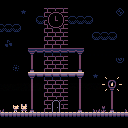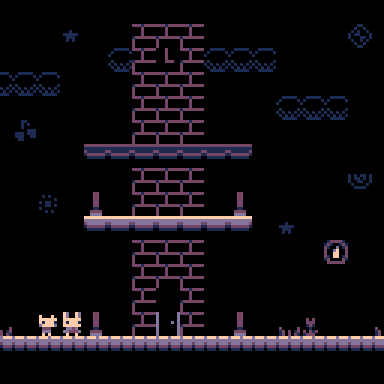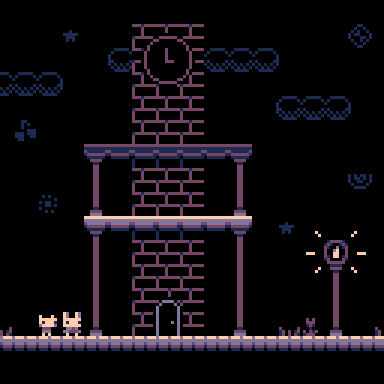i made a spooky scene to test if i could generate visual details procedurally — yes, i could
before i could create the full scene, i made a fake screenshot in a pixel art editor
so i could look at the picture and imagine which commands i would need to add the details
behind the scenes
warning: long text
cost
this scene uses 18 out of 63 sprites from the first sprite page
at the cost of 563 out of 8192 tokens.
if i had drawn the decorations in the spritesheet, i would have saved all tokens — at the cost of 22 more sprites
- 4 more pillar sprites
- 1 long connecting piece
- 3 tile variations of the capital (the top of the pillar)
- capital below light ledge
- capital below dark ledge
- capital below lamp
- 6 sprites for the emission lines around the lamp
- 1 sprite for the top part of the door
- 9 sprites for the clock face and surrounding wall
- 2 sprites to complete the outlines of the clouds
the original 18 sprites with these 22 more sprites would be 40 sprites. this would leave only 23 more sprites on the first sprite page

Here now, @Sosasees.
If you use poke(0x5f2e,1) inside your code, when it exits you can edit your sprites in the color set you chose via your _draw() function.
Use pal() either in your code or immediate mode or type RUN with no palette changes to return back to your normal colors.

thank you @dw817 very much for the tip.
this was very useful for 'new profile picture 2023-01-01' and will be very useful later

i was now a programmer of PICO-8 cartridges
for long enough that
i am convinced that
almost every programmer of PICO-8 cartridges
has invented procedural visuals generation
independently
because i have played cartridges that use procedural visuals generation
that were made long before this one — and newer ones, where i am convinced that the creator has never seen this post

Yes Autotiling and drawing extra bits is very helpful. feels really broad honestly, like adjusting how you draw sprites or just completely adding new stuff for various effects
[Please log in to post a comment]










